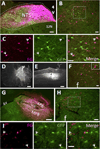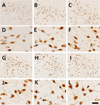Neuroanatomy of melanocortin-4 receptor pathway in the lateral hypothalamic area
- PMID: 22605619
- PMCID: PMC3652326
- DOI: 10.1002/cne.23145
Neuroanatomy of melanocortin-4 receptor pathway in the lateral hypothalamic area
Abstract
The central melanocortin system regulates body energy homeostasis including the melanocortin-4 receptor (MC4R). The lateral hypothalamic area (LHA) receives dense melanocortinergic inputs from the arcuate nucleus of the hypothalamus and regulates multiple processes including food intake, reward behaviors, and autonomic function. By using a mouse line in which green fluorescent protein (GFP) is expressed under control of the MC4R gene promoter, we systemically investigated MC4R signaling in the LHA by combining double immunohistochemistry, electrophysiology, and retrograde tracing techniques. We found that LHA MC4R-GFP neurons coexpress neurotensin as well as the leptin receptor but do not coexpress other peptide neurotransmitters found in the LHA including orexin, melanin-concentrating hormone, and nesfatin-1. Furthermore, electrophysiological recording demonstrated that leptin, but not the MC4R agonist melanotan II, hyperpolarizes the majority of LHA MC4R-GFP neurons in an ATP- sensitive potassium channel-dependent manner. Retrograde tracing revealed that LHA MC4R-GFP neurons do not project to the ventral tegmental area, dorsal raphe nucleus, nucleus accumbens, and spinal cord, and only limited number of neurons project to the nucleus of the solitary tract and parabrachial nucleus. Our findings provide new insights into MC4R signaling in the LHA and its potential implications in homeostatic regulation of body energy balance.
Copyright © 2012 Wiley Periodicals, Inc.
Conflict of interest statement
Conflict of Interest: None
Figures






References
-
- Balthasar N, Coppari R, McMinn J, Liu SM, Lee CE, Tang V, Kenny CD, McGovern RA, Chua SC, Jr, Elmquist JK, Lowell BB. Leptin receptor signaling in POMC neurons is required for normal body weight homeostasis. Neuron. 2004;42(6):983–991. - PubMed
-
- Balthasar N, Dalgaard LT, Lee CE, Yu J, Funahashi H, Williams T, Ferreira M, Tang V, McGovern RA, Kenny CD, Christiansen LM, Edelstein E, Choi B, Boss O, Aschkenasi C, Zhang CY, Mountjoy K, Kishi T, Elmquist JK, Lowell BB. Divergence of melanocortin pathways in the control of food intake and energy expenditure. Cell. 2005;123(3):493–505. - PubMed
Publication types
MeSH terms
Substances
Grants and funding
LinkOut - more resources
Full Text Sources

